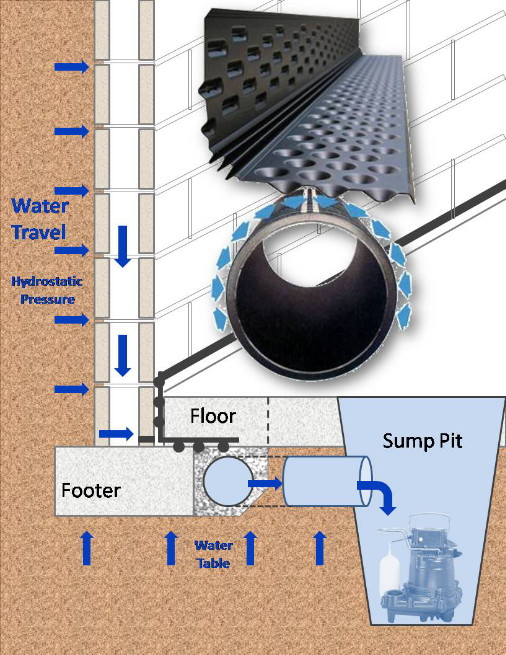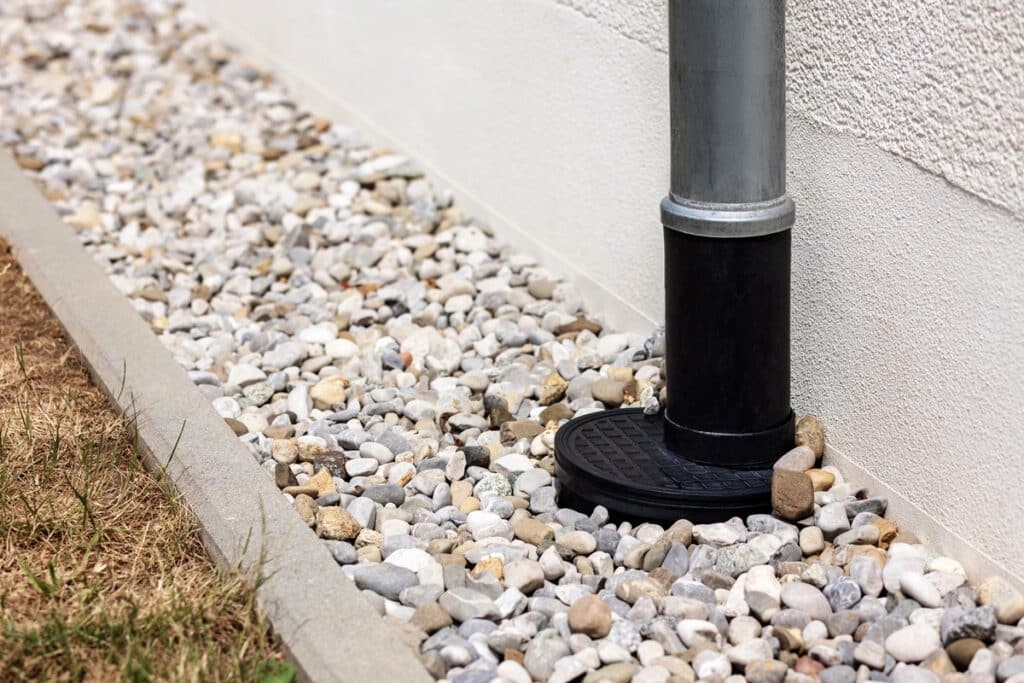The Crucial Overview to Preserving Your French Drain for Long-Lasting Efficiency
Preserving your French drainpipe is key to its effectiveness and your residential or commercial property's defense. Regular checks can conserve you from costly fixings and water damages. You'll need to know what indicators to look for and exactly how usually to check your system. Plus, understanding the cleansing process can make a substantial difference. Let's explore the essential steps for guaranteeing your drainpipe works well for many years ahead.
Understanding the Function of a French Drain
A French drainpipe is a critical component in managing water around your home. It routes excess water away from your structure, stopping flooding and damage. When heavy rain drops, the drainpipe accumulates water via a perforated pipe hidden in gravel. This system permits water to flow openly, minimizing stress on your basement wall surfaces and minimizing the threat of leaks.You may ask yourself just how it works in method. As water fills the dirt, gravity draws it toward the drainpipe. The perforated pipe captures this water, transporting it to a designated drain location or storm drain. This process maintains your lawn completely dry and secures your home's structural integrity.Understanding just how a French drain features is vital to appreciating its value. By effectively directing water away, it aids maintain a safe and completely dry living setting. Maintaining your French drain in top condition warranties you avoid expensive repair work down the line.
Routine Assessments: What to Look For
Beginning by checking for any blockages that may be blocking water circulation when you're inspecting your French drain. Pay interest to indications of surface area erosion around the drainpipe, as this can indicate potential problems. Routine assessments will certainly aid keep your drain system working efficiently.
Clogged Drainpipe Analysis
Exactly how can you tell if your French drain is obstructed? Watch for water pooling in your yard, especially after heavy rain. If you notice areas where water gathers rather than draining pipes, that's a warning. You ought to also check the drainpipe electrical outlet; if water isn't draining as it should, there's likely an obstruction. Listen for unusual gurgling audios, which can show trapped air. Furthermore, examine the drain's surface area for any kind of plants growth, as roots can block the system and infiltrate. If you scent musty smells, it can aim to stationary water triggered by a clog. Consistently evaluating these indicators can aid you preserve your French drain efficiently and protect against pricey fixings.
Surface Area Erosion Check

Cleaning Your French Drain: Step-by-Step Overview
Cleaning your French drain is essential for keeping it operating correctly. You'll require some particular devices and a clear procedure to guarantee every little thing runs smoothly. Let's go through the steps and ideas for maintaining your drain successfully.
Tools You'll Need
To tackle the job of cleansing your French drainpipe efficiently, you'll want to collect a couple of crucial tools. First, get hold of a tough set of gloves to shield your hands from particles and sharp things. A little shovel or trowel will certainly aid you remove dirt or obstructions around the drain. For cleaning out the interior, a plumber's snake or a high-pressure water nozzle can be exceptionally useful. You'll also need a container for gathering any kind of particles you draw out. Having a garden tube on hand will certainly make it much easier to wash out the drain and guarantee it's moving efficiently. With these tools all set, you'll be set for a detailed cleansing session!
Cleaning Up Process Actions
Begin by examining the area around your French drainpipe for any type of visible particles or obstructions. Eliminate leaves, branches, or dust that may block water flow. Next, examine the inlet and outlet locations; clear any type of obstructions to assure appropriate drainage. Make use of a garden hose to purge the drain, routing water into the inlet. This helps remove any gathered sludge or sediment. If you notice relentless blockages, consider making use of a plumbing technician's serpent to break them up. After cleaning, inspect the crushed rock around the drain; renew it if it's cleaned away. Verify the drain covers are undamaged and securely in location to protect against debris from going into. Normal cleaning keeps your French drainpipe functioning efficiently.
Upkeep Regularity Tips
While regular maintenance is crucial for your French drain's durability, recognizing how typically to keep it can make all the distinction. Ideally, you ought to check your French drainpipe at least twice a year, ideally in springtime and loss. After heavy rainfall or snowmelt, check for obstructions or particles. If you see any standing water, it's time to clean your drain.In areas with heavy foliage, more regular upkeep-- concerning every 3 months-- may be needed. In addition, take into consideration cleaning your French drain after major storms or if you observe water pooling in your yard. By staying positive, you'll ensure your French drain functions efficiently and safeguards your home from water damage. Routine checks will save you money and time in the future.
Identifying Common Issues and Their Solutions
When you discover water pooling in your yard or damp spots in your cellar, it's essential to recognize usual concerns with your French drainpipe and carry out efficient services. One frequent problem is obstructing, usually brought on by particles like leaves or sediment. To repair this, you can utilize a plumbing snake or a high-pressure water jet to clear blockages.Another concern may be incorrect slope. Water won't stream away from your home if your drain isn't sloped appropriately. You can change the slope by excavating and rearranging the drain pipe.Lastly, look for damages or fractures in the drainpipe itself. Changing the damaged areas is important for peak efficiency if you find any kind of. By resolving these problems promptly, you'll aid guarantee that your French drainpipe continues to operate efficiently, shielding your property from water damages and maintaining a dry, secure atmosphere.
Seasonal Upkeep Tips for Your French Drain
Attending to common issues with your French drainpipe is just the initial action in ensuring its lasting effectiveness. Seasonal maintenance is essential for peak performance. In the spring, eliminate leaves and debris that may have collected during winter season. Look for any obstructions in the electrical outlet or capture basin, as water needs a clear course to move freely.During summer, examine your drainpipe for any kind of signs of clearing up or changing dirt. Ensure it's right here still level and working appropriately. As loss approaches, clean out any type of dropped leaves to protect against clogs prior to winter arrives.In winter, look for freezing temperatures. If you stay in a cool environment, make certain your drainpipe isn't in jeopardy of cold. Shielding revealed pipelines can aid. Normal checks and prompt upkeep can protect against pricey fixings and maintain your French drainpipe functioning successfully year-round. Remain positive and take pleasure in assurance understanding your drain system is in good condition!
When to Call in a Professional
When to call in a specialist can save you time and avoid further damages to your French drainpipe, understanding. If you discover persistent standing water in your backyard, it's a clear indication that your drain might be obstructed or damaged. Do not disregard strange odors, as they can show sewage back-up or decay, which needs immediate attention.If you locate that your drain isn't functioning effectively after attempts to tidy or preserve it, it's time to connect for specialist help. In addition, if you're not sure about the underlying concerns or lack the essential tools, working with an expert can provide peace of mind.Finally, if your French drainpipe is old or has experienced substantial deterioration, professional analysis can identify whether fixings or total substitute is needed. Trust fund the professionals to assure your drainage system functions efficiently for several years to come.
Tips for Stopping Future Drainage Issues
To keep your French drain functioning successfully, consistently examining and keeping it can make all the difference. Begin by getting rid of debris, leaves, and dirt from the surface area and drainpipe openings. This prevents obstructions that can cause water back-up. Check the gravel around the drainpipe; if it's compressed or eroded, see here now think about including fresh crushed rock to maintain perfect flow.Next, draw away water far from your drainpipe by ensuring seamless gutters and downspouts are clear and guiding water a minimum of 3 feet far from your structure. Routinely check for any kind of indicators of damage or sagging. If you discover problems, address them immediately.Finally, take into consideration mounting a catch or a filter basin to trap larger debris before it goes into the drainpipe. By remaining aggressive with these tips, you'll reduce the danger of future drain troubles and maintain your French drain in top shape.
Often Asked Concerns
How much time Does a French Drain Typically Last?
A French drainpipe generally lasts around 30 to 40 years, depending upon the materials utilized and maintenance (Portland French Drain). If you stay up to date with regular checks, you can extend its life-span also better
Can I Mount a French Drainpipe Myself?
Yes, you can set up a French drain yourself if you have actually obtained the right devices and understanding. Just make sure to prepare very carefully, comply with local regulations, and warranty correct water drainage to prevent future problems.
What Materials Are Used in a French Drainpipe?
You'll need perforated pipe, gravel, landscape textile, and a strong drainage pipeline for your French drainpipe. These materials help reroute water effectively, preventing flooding and maintaining your home secure and dry from water damage.

Is a License Required to Set Up a French Drain?
You'll likely need a permit to install a French drain, depending on neighborhood laws. Consult your district to assure you abide by any type of needed guidelines and avoid potential concerns throughout setup.
What Are the Costs Related To French Drainpipe Upkeep?
Preserving a French drain usually costs in between $100 and $500 every year. You'll require to take into account expenses for cleansing, repair services, and assessments. Routine maintenance aids stop larger expenses and warranties your system operates effectively for many years - Portland French Drain. When you're examining your French drainpipe, begin useful link by checking for any kind of blockages that might be blocking water circulation. By staying aggressive, you'll assure your French drainpipe functions successfully and safeguards your residential or commercial property from water damages. When you discover water merging in your lawn or damp places in your basement, it's essential to determine usual problems with your French drainpipe and execute reliable services. You can readjust the slope by digging and rearranging the drain pipe.Lastly, check for damages or cracks in the drain itself. Examine the gravel around the drain; if it's compressed or eroded, take into consideration adding fresh gravel to keep perfect flow.Next, draw away water away from your drainpipe by making sure seamless gutters and downspouts are clear and routing water at the very least three feet away from your foundation